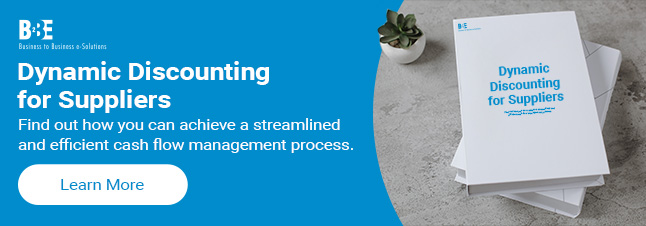This blog explores what is dynamic discounting, highlighting the key features, and how it compares to traditional discounting. Read on to understand if your organisation could benefit from Dynamic Discounting.
Cashflow management is a critical part of any business success. However, more so than ever businesses are struggling with late payments. An average of around 43% of businesses’ invoices are paid late. Add this to the 62% off small businesses, that are paid 23 days beyond agreed payment terms. Late payments are actively disrupting operations, straining relationships with trading partners, and hindering growth opportunities. That’s why it’s crucial for organisations to proactively manage their payment processes and seek innovative solutions to optimise cash flow.
The solution? Dynamic Discounting – but, what is Dynamic Discounting? It’s a powerful tool that enables businesses to unlock the benefits of early payment discounts or negotiate favorable payment terms with suppliers and buyers.
By gaining a solid understanding of dynamic discounting and how it improves cash flow management, organisations can address payment challenges. As well as fostering healthy relationships with their trading partners.
What is Dynamic Discounting: Understanding the Basics
Dynamic discounting is a supply chain finance solution that enables businesses to offer or request discounts on invoices in exchange for faster payment terms. It allows buyers and suppliers to optimise their cash flow by negotiating favourable payment terms and taking advantage of early payment discounts. Unlike the traditional methods that require third-party financing, dynamic discounting is typically facilitated through a digital platform. This enables communication and negotiation between trading partners.
How Dynamic Discounting Works for both Buyers and Suppliers: An Overview
For Buyers:
Dynamic discounting offers buyers the opportunity to negotiate favorable payment terms with their suppliers in exchange for early payment. Here’s how it typically works:
- Invoice Submission: Buyers submit their invoices to the Dynamic Discounting platform
- Discount Offers: The platform automatically calculates the potential discount amount based on the selected discount either using discount or APR% for early payment discounts.
- Supplier Decision: Both the Buyers and their Suppliers can choose to accept or reject the discount offer based on their cash flow needs and business requirements. If accepted, the early payment discount is applied to the invoice.
- Payment: If the supplier accepts the discount offer, the buyer pays the discounted invoice amount to the supplier within the agreed-upon timeframe, typically faster than the original payment terms.
- Win-Win: The buyer benefits from taking advantage of early payment discounts, which can improve cash flow, strengthen supplier relationships, and potentially negotiate better terms in the future. Suppliers benefit from receiving faster payment and improving their cash flow position.
For Suppliers:
Dynamic discounting offers suppliers the flexibility to receive early payment in exchange for offering discounts to buyers. Here’s how it typically works from the supplier’s perspective:
- Invoice Submission: Suppliers submit their invoices to the Dynamic Discounting platform, just like in traditional invoicing processes.
- Discount Offers: The platform automatically calculates the potential discount amount. This is based on the agreed-upon early payment terms and presents it to the supplier.
- Supplier Decision: Suppliers can choose to offer early payment discounts to buyers in exchange for faster payment. This is based on their cash flow needs and business requirements. If accepted, the early payment discount is applied to the invoice.
- Payment: If the buyer accepts the discount offer, the buyer pays the discounted invoice amount to the supplier within the agreed-upon timeframe. This is typically faster than the original payment terms.
- Win-Win: The supplier benefits from receiving early payment, improving cash flow, and potentially gaining a competitive edge by offering attractive payment terms to buyers.
Dynamic discounting provides a win-win solution for both buyers and suppliers. This is because it allows buyers to optimise their cash flow and suppliers to improve their cash flow position while strengthening trading relationships.
It’s a flexible and mutually beneficial approach to managing payment terms and accelerating cash flow for businesses of all sizes.
Dynamic Discounting vs. Traditional Discounting: A Comparison
Dynamic discounting is a flexible and real-time solution that allows businesses to negotiate early payment discounts based on their current cash flow needs. It is facilitated through a digital platform that enables communication, negotiation, and processing of discount offers between buyers and suppliers.
On the other hand, traditional discounting typically involves third-party financing, such as factoring or invoice discounting. This is where a financial institution advances a portion of the invoice value to the supplier or buyer in exchange for a fee or interest. Traditional discounting may have more rigid payment terms and may therefore not offer the same level of flexibility and real-time communication as dynamic discounting.
Now, let’s continue with the comparison section:
Dynamic Discounting:
- Flexibility: Dynamic discounting offers flexibility in terms of negotiating early payment discounts between buyers and suppliers. The discount percentage, payment terms, and timing can be customised based on the needs of both parties. Users can select specific invoices within the platform and can also negotiate using APR% instead of discount.
- Real-time Communication: This type of solution is facilitated through a digital platform that enables real-time communication and negotiation between buyers and suppliers. This therefore allows for quick decision-making and efficient processing of discount offers and payments.
- Automated Processing: It leverages automation to streamline the invoice payment process, reducing manual effort and accelerating payment cycles. The digital platform automates the calculation of discount amounts, submission and review of discount offers, and processing of payments, making it efficient and convenient for both buyers and suppliers.
Traditional Discounting:
- Third-party Financing: Traditional discounting involves third-party financing, such as factoring or invoice discounting, where a financial institution advances a portion of the invoice value to the supplier or buyer in exchange for a fee or interest. This may involve additional costs. It may also not provide the same level of flexibility as dynamic discounting due to lengthy KYC processes and compliance.
- Fixed Payment Terms: Traditional discounting may have more rigid payment terms, as the financing arrangement may dictate the payment terms and timing. This may not allow for customisation based on the specific cash flow needs of the buyers and suppliers.
- Manual Processing: Traditional discounting may involve more manual processing. For example, submission of paper invoices and manual review of discount offers and payments. This may result in longer processing times and increased administrative effort compared to dynamic discounting.
Dynamic Discounting offers flexibility, real-time communication, and automated processing. Meanwhile traditional methods may involve third-party financing, fixed payment terms, and manual processing. Understanding the differences between dynamic and traditional discounting can help businesses choose the most suitable solution for their cash flow management needs.
A Win-Win Solution for Buyers and Suppliers
Dynamic discounting shows clear benefits for both buyers and suppliers, making it a win-win situation for both parties. Both, allowing buyers to improve their cash flow by allowing them to make the most of their working capital through early payment discounts, reducing reliance on external finance and potentially unlocking additional discounts for quick and prompt payments. And giving suppliers access to funds faster, improving cash flow and potentially reducing borrowing costs.
It streamlines operations by leveraging automation to streamline the invoice payment process. This is in addition to reducing manual effort, increasing processing times, and enhancing operational efficiency for both buyers and suppliers.
So, what is Dynamic Discounting? And is it something your business should consider?
Dynamic Discounting is a modern and flexible solution that offers a win-win solution for both buyers and suppliers. It optimises cash flow, streamlines operations, strengthens supplier relationships, and provides a competitive advantage. Implementing this solution as a strategic financial solution can help businesses optimise their payment processes and improve their working capital management strategies.


